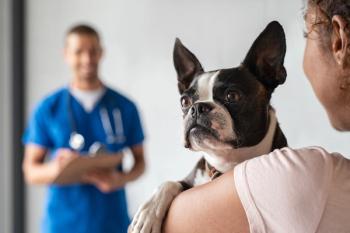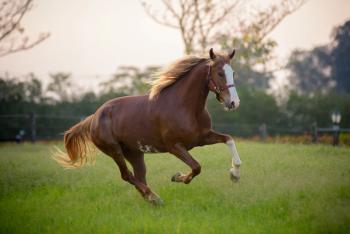
Intracorporeal suturing in minimally invasive surgery
Minimally invasive surgery is a rapidly developing discipline in veterinary medicine, thanks to its widespread use in human medicine. During the past 20 years, veterinarians have watched a temporally similar development with arthroscopic surgery. While minimally invasive surgery has many advantages over traditional open surgery—including reduced postoperative pain, reduced recovery times, and improved operative results—there is a caveat: It requires specialized training and considerable experience. In this article, I'll focus on one particular minimally invasive technique—intracorporeal suturing.
Minimally invasive surgery is a rapidly developing discipline in veterinary medicine, thanks to its widespread use in human medicine. During the past 20 years, veterinarians have watched a temporally similar development with arthroscopic surgery. While minimally invasive surgery has many advantages over traditional open surgery—including reduced postoperative pain, reduced recovery times, and improved operative results—there is a caveat: It requires specialized training and considerable experience. In this article, I'll focus on one particular minimally invasive technique—intracorporeal suturing.
John C. Huhn, DVM, MS
The power of ports
Intracorporeal suturing involves suturing within a body cavity (abdomen or thorax) through one or more operative ports. Laparoscopic ports generally accept surgical instruments with diameters ranging from 5 to 12 mm. Furthermore, these ports incorporate a one-way seal that prevents insufflating gas (generally CO2) from escaping during operative manipulations. Thoracoscopic ports accept instruments with the same diameters, but they generally don't include seals that prevent gas from escaping because the lung is allowed to collapse during surgery.
Figure 1: Endo Stitch device (Tyco Healthcare/Kendall Animal Health). Figure 2: At the Endo Stitch training station, two 5-mm-to-12-mm laparoscopic ports are used to insert the Endo Stitch device, and laparoscopic grasping forceps are used to suture simulated wounds in the central foam block. An angled plexiglass sheet is affixed to the rear of the training station to support the Endo Stitch knot-tying manual.
One of the most important goals of minimally invasive surgery is to perform it in a hemostatic and atraumatic closed environment. New laparoscopists frequently begin a given procedure as a minimally invasive one, only to convert to an open procedure when technical problems arise. With patience, time, and experience, laparoscopists can perform minimally invasive surgical techniques from start to finish. In the interim, many choose to use a laparoscopic-assisted technique until their proficiency improves. One such technique is intracorporeal suturing, which allows veterinarians to place hemostatic or appositional ligatures through conventional laparoscopic or thoracoscopic ports.
Figure 3: Knot-tying Techniques-Square Knot
Variation on a conventional method
Veterinarians can perform intracorporeal suturing by using specialized needle graspers and conventional suture material or a specialized suturing device, such as Endo Stitch (
Figure 1
). The first method is difficult to master and requires expensive instrumentation. The latter method is considerably easier, and the required equipment is much more affordable. Furthermore, the Endo Stitch device comes with a training station (
Figure 2
), which allows laparoscopic surgeons to practice knot-tying before intraoperative use (
Figure 3
).
The Endo Stitch device features a 10-mm diameter shaft of variable length (20 to 35 cm), with toggling needle-passing jaws at one end (Figure 4) and operating controls at the other (Figure 5). Arming the device requires the veterinarian to insert the instrument's jaws into a specialized suture-loading unit, which contains a double-pointed needle that accommodates a variable length (7 to 48 in) of absorbable or nonabsorbable suture material. Upon arming the device, the suture needle may be alternately transferred from one jaw to the other by squeezing the grasping handles and moving the toggle button up and down.
Figure 4: Needle-passing jaws on an Endo Stitch device. Figure 5: Operating handles and toggle buttons on an Endo Stitch device.
Numerous knot configurations are possible with the Endo Stitch device, including a square knot (Figure 3), a surgeon's knot, a modified fisherman's knot, and a tailspin knot (an alternative to the square knot). In addition, veterinarians can easily place simple interrupted or continuous suture patterns, as dictated by the operative procedure.1
A recent study compared the suture placement accuracy, knot-tying speed, and knot strength of conventional laparoscopic suturing tools with the Endo Stitch device.2 Test material included a pelvic trainer (similar to the Endo Stitch trainer), 2-0 polyester suture, and swine urinary tract tissues. A tensiometer assessed suture knot strength, and the results were comparable. Knot-tying speed was about two times faster with the Endo Stitch device than with conventional laparoscopic suturing tools. The suture placement accuracy of both methods was equivalent.
Considering the difficulty in becoming proficient with conventional laparoscopic suturing, this study provides strong support for the use of the Endo Stitch device in laparoscopic surgery.
References
1. Intracorporeal Knot Tying with the Endo Stitch. Tyco Healthcare/Kendall Animal Health, 2004
2. Pattaras, J.G. et al.: Comparison and analysis of laparoscopic intracorporeal suturing devices: Preliminary results. J. Endourol.15 (2):187-192; 2001.
Dr. John C. Huhn develops liaisons with veterinary colleges in the United States and conducts wet labs and seminars that promote Davis & Geck wound closure products and Tyco/Kendall Healthcare wound care products. Dr. Huhn received his DVM degree from Michigan State University in 1980 and his masters degree in 1987 from the University of Illinois.
Newsletter
From exam room tips to practice management insights, get trusted veterinary news delivered straight to your inbox—subscribe to dvm360.






